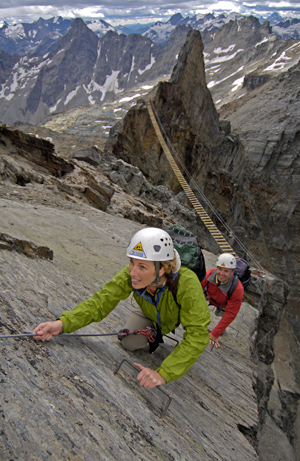We’re leaving the ski area. You can’t really blame us. The ungroomed, untouched and unbelievable terrain and snow outside the ski area boundary is the stuff of skier’s dreams.
Not only are the snow quality and the terrain of wilderness skiing dream-worthy, but today’s equipment makes deep powder skiing easier and more accessible than ever. According to Backcountry Magazine, backcountry skier visitation has risen 124% since 2009. But what’s up with all the different words that are used to describe it?
Europeans call it off-piste, and it’s become so popular in Canada and the US that the different flavors of unbounded snow riding have developed their own North American nomenclature.
Here are the Heli-Ski Blog’s definitions of the backcountry bonanza:
Sidecountry:
Several leading outdoor gear companies have watched “sidecountry” become their fastest growing product category. For good reason. Sidecountry is generally defined as using ski lifts to get up the mountain, and then leaving the ski area through approved gates to access the goods.
European ski areas have allowed sidecountry skiing since the first ski lifts we installed, but it was slower to catch on in North America. Areas like Washington’s Mt. Baker were instrumental in making sidecountry skiing an acceptable part of this continent’s ski area management. Many ski areas now require skiers to carry avalache gear when leaving the resort.
Frontcountry:
This is easy-access backcountry skiing. Places such as the more user-friendly canyons of Utah’s famed Wasatch Range inspired the term frontcountry. This is where you have to ski or hike up to earn your turns, but if you break a ski you can fairly easily wallow down the hill to the car.
Good frontcountry destinations have become so popular that early-bird strategies can be necessary to get the freshies after a dump.
Slackcountry:
A slacker’s version of frontcountry. Teton Pass in Wyoming, Stevens Pass in Washington, and Berthoud Pass in Colorado are perfect slackcountry destinations. Drive to the pass, ski or hike as far up as you want, and then rip powder turns to meet the road far below your car. Hitch a ride back to the pass with an understanding ski bum. Repeat as often as possible.
Roger’s Pass, near North America’s powder skiing epicentre of Revelstoke, British Columbia, has roadside backcountry access that almost falls into the slackcountry category, but the size and complexity of the terrain make it suitable for only the more motivated and experienced slackers.
Backcountry:
Whatever you call it, anywhere without ski patrol actively working must be treated as backcountry skiing, even skiing inside a ski area before or after the resort’s open season. Just because you’re near your car, ski lifts, or other skier’s tracks doesn’t mean you’re safe from avalanches and other backcountry hazards. In fact, being around a lot of other skiers, tracks, cars and lifts can create a complacent attitude about risk.
The remote wilderness skiing around Revelstoke in British Columbia’s Interior ranges, where CMH Heli-Skiing operates, has become known worldwide as the ultimate deep powder backcountry skiing destination.
To go side, slack, front or back, here are a few starter tips:
- Take basic avalanche training, then carry and know how to use a transceiver, shovel and probe.
- Hire a ski guide. Even experienced backcountry skiers find that hiring a guide is a great way to learn a new area and find the best terrain.
- Ski with friends who are experienced but not overly aggressive.
- Learn what safer ski lines look like, and stick to them – safe terrain choices are easier to get right than snowpack evaluations.
- Always check the current local avalanche forecast, and then ski accordingly.
At CMH, we’ve been exploring some of the snowiest, biggest backcountry on earth for over half a century. In 1965, we invented Heli-Skiing to show more people the wonders of British Columbia’s backcountry, the place many people consider home to the world’s greatest skiing. Today, we continue to reinvent backcountry skiing with programs such as Heli-Assisted Ski Touring and Ski Fusion.
Photos by Topher Donahue.




Comments